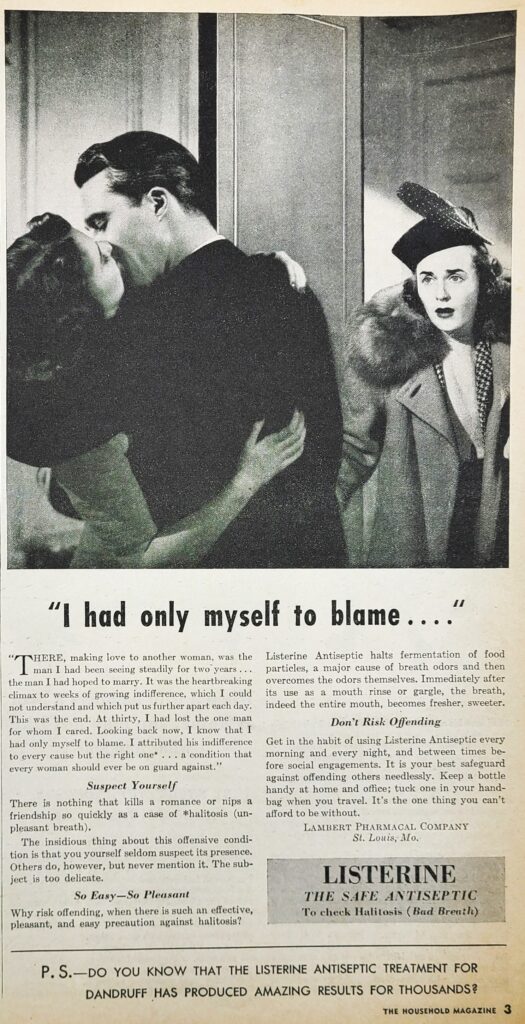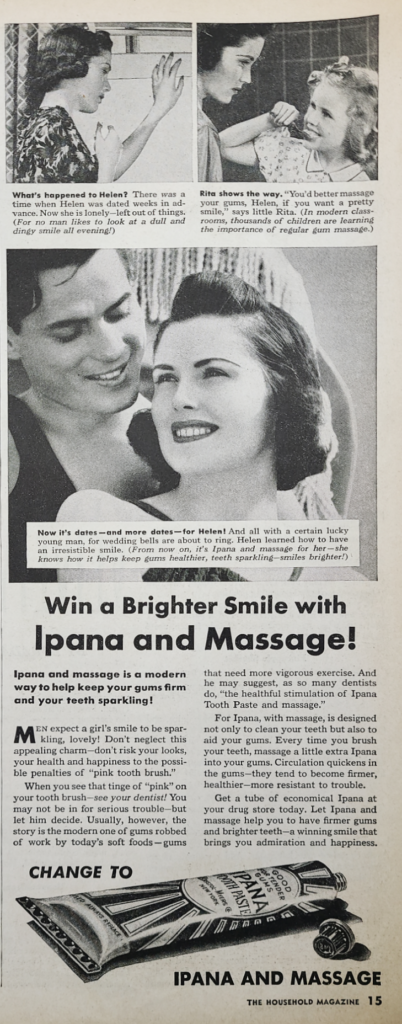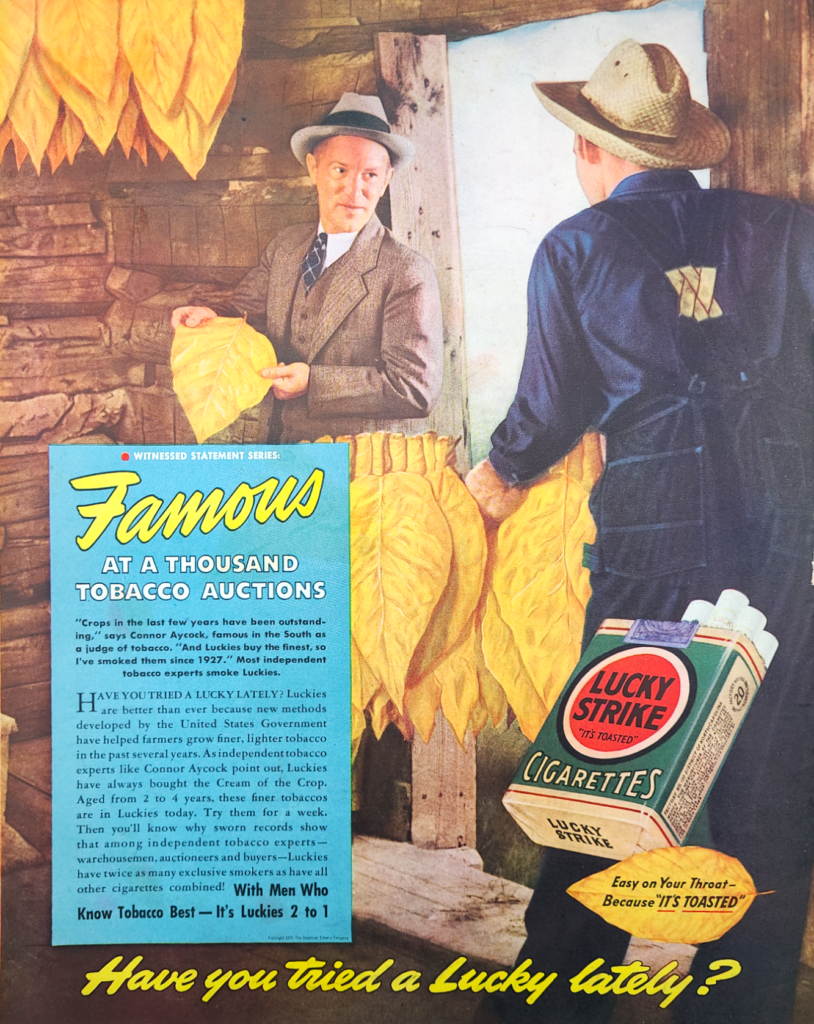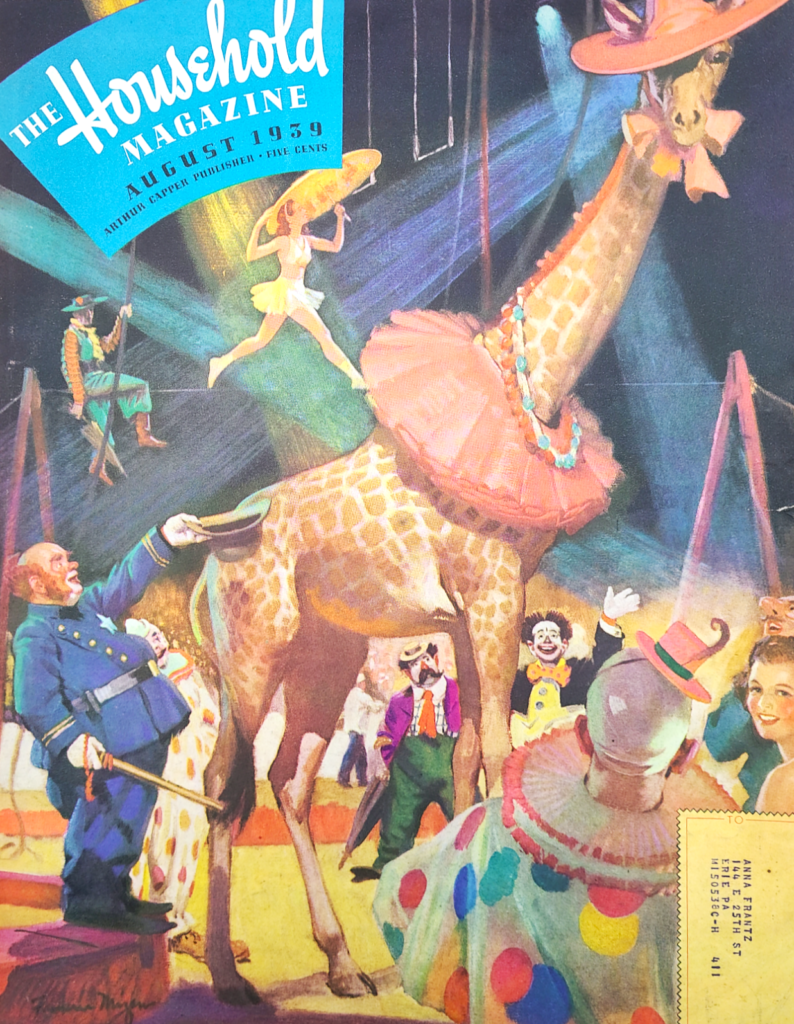The Household Magazine was produced monthly by Arthur Capper Publications in Topeka Kansas. This magazine targets the female audience of the time with Ads, articles and recipes all directed at housewives and women who hope to attract men.
The magazine itself is a nice thin publication that could easily be framed and displayed. The cover is very artistic with an attractive circus scene that is full of color.
If you like this item, we have many more like it in our shop at PFTPAntiques. Please stop by and look through our inventory.
LISTERINE TO SAVE YOUR RELATIONSHIP

By the late 1930’s women had already gained the right to vote and were becoming less dependant on men through increased employment opportunities in service industries. However, the bulk of relationships still saw women as traditional housewives. The man was generally responsible for working and providing the family income. Therefore, the thought of not catching a good man, must have been a very frightening possibility for many young women.
In this advertisement, Listerine is playing off that fearful prospect by implying that a man is likely to leave a long term committed relationship due to bad breath. Furthermore, it would be the woman’s own fault for not simply using their product as part of her daily oral hygiene.
In reality, bad breath (halitosis) was not really considered to be that much of a problem in the early 1900’s. It was this aggressive advertising campaign that made halitosis seem like a serious problem and by playing off people’s fears, Listerine created a huge market for their product. In less than a decade, Listerine profits increased from a little over $100,000 to more that $8 million per year. Although I may not approve of the early advertising strategies, I do like the product.
At the bottom of this ad there is an additional statement that identifies Listerine as a beneficial product for dandruff treatment. I wasn’t sure about this claim, so I looked into it and a quick search showed that many people still use Listerine to help with dandruff. Apparently, ingredients like menthol, thymol, methyl salicylate, and eucalyptol give this product the necessary properties to treat dandruff.
IPANA AND MASSAGE TOOTHPASTE FROM BRISTOL-MYER

Ipana was a toothpaste produced by the Bristol-Myers company starting in 1901. Bristol-Myers continued to sell this product in the United States until 1979, but stopped in pursuit of more profitable alternatives.
Once again with this ad, female consumers are fed the idea that men will not want them. In this case, it is dull teeth that will drive the guys away and leave her home alone. As I write this post and watch TV, I’m reminded that the tactic is still being used today. Both men and women are bombarded with advertising that shows how people of the opposite sex will be drawn to them if they use a certain product. I guess if this form of advertising continues to work, then there is no need to re-invent the process.
Regarding the massage part of Ipana and Massage, it seems that many dental websites do recommend massaging gums to stimulate blood flow and promote healthy gums. However, you should confirm with your dentist what treatments are appropriate for you
LUCKY STRIKE CIGARETTE ADVERTISMENT
This Lucky Strike advertisement is located on the back cover of the magazine. Contrary to the way the previous ads used fear, Lucky Strike lays out a case for the quality of what they sell. They use apparent expert testimony to confirm the high standard of the tobacco product. Additionally, they make sure to inform us that most of these experts specifically choose to smoke Luckies.
I have never been a smoker, but I have always found these ads to be very visually attractive. In this case, I interpret it as a scene that would lead us to believe Lucky Strike is buying from average hard-working farmers. Maybe trying to imply that they support and work with average people like the ones who buy Lucky Strike cigarettes.
A couple interesting notes regarding Lucky Strike cigarettes:
- There is an urban legend that the name “Lucky Strike” refers to some cigarettes containing marijuana.
- In the 1930’s, women didn’t like Lucky Strike because of the package color. Instead of changing the color of the packaging, Lucky Strike put forward large efforts to make the color green fashionable.

We hope you enjoyed this look at some of the ads from the August 1939 issue of The Household Magazine. There is a lot more interesting information within this magazine, so if you want to check it out you can buy it in our shop here.
Many readers may have focused interests and might be able to provide more information about some of the items in these ads. We would love it if you post any additional information in the comments section.
If you find our posts interesting, please follow us on Pinterest or X to see when we add new content, new products in our shop or start a sale. You can also visit and follow our shop PFTPAntiques directly to see our more of our inventory.
